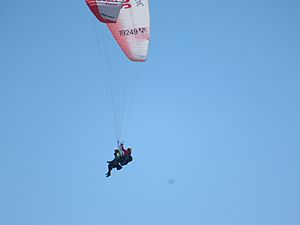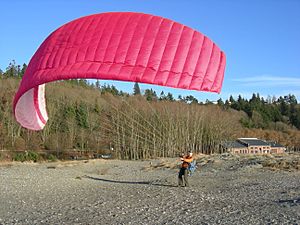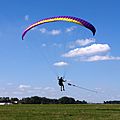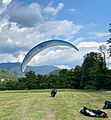Paragliding facts for kids
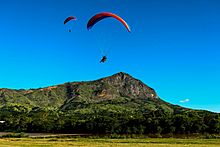
Governador Valadares, Brazil is known internationally for the World Paragliding Championships that has been held at Ibituruna Peak (1123 metres).
|
|
| Highest governing body | Fédération Aéronautique Internationale |
|---|---|
| Characteristics | |
| Contact | No |
| Mixed-sex | Yes |
| Type | Air sports |
| Presence | |
| Country or region | Worldwide |
| Olympic | No |
| World Games | 2013 |
Paragliding is an exciting adventure sport. It involves flying a paraglider, which is a special type of aircraft. Paragliders are light and do not have an engine. They also do not have a hard frame like an airplane.
A pilot sits in a harness that hangs below a fabric wing. This wing gets its shape from ropes called suspension lines. Air pressure also helps, as air enters openings at the front of the wing. The way air moves over the wing also keeps its shape.
Even without an engine, paragliders can fly for many hours. They can travel hundreds of kilometers. However, most flights last one to two hours. They usually cover a few tens of kilometers. Pilots can go higher by finding areas of rising air. They can often climb thousands of meters into the sky.
Contents
How Did Paragliding Start?
Early Ideas and Inventions
In 1952, a Canadian named Domina Jalbert had a new idea. He patented a special parachute that could be steered. It had many cells and controls to glide sideways.
In 1954, Walter Neumark wrote about a future idea. He imagined a pilot launching from a cliff or slope. This would be like a summer activity for ski resorts.
In 1961, French engineer Pierre Lemongine made better parachutes. One was called the Para-Commander. It had cutouts that allowed it to be pulled into the air. This led to sports like parasailing.
Domina Jalbert also invented the Parafoil. This wing had many sections shaped like an airplane wing. It had an open front and a closed back. Air would fill it as it moved, like a "ram-air" design. He patented this idea in 1963.
Around that time, David Barish worked on a "sail wing." This was a single-surface wing for NASA space capsules. He tested it by "slope soaring." This meant gliding down a slope. After tests in New York in 1965, he promoted slope soaring. He thought it could be a summer sport for ski resorts.
The Birth of Modern Paragliding
Walter Neumark wrote a book about using ascending parachutes. In 1973, he and other enthusiasts formed a new group. They loved launching parachutes by towing them. This group later became the British Hang Gliding and Paragliding Association. Neumark received a special award in 1997.
In 1985, Patrick Gilligan and Bertrand Dubuis wrote the first flight manual. They called it The Paragliding Manual. This is where the word "paragliding" came from.
In June 1978, three friends in France combined these ideas. Jean-Claude Bétemps, André Bohn, and Gérard Bosson were inspired by an article. They realized a "square" ram-air parachute could be launched. You just needed to run down a suitable slope.
Bétemps launched from a peak in Mieussy, France. He flew 100 meters. Bohn followed him and glided 1000 meters down to a football field. This moment marked the beginning of "Parapente," which is French for "slope parachute."
Growth and Competitions
Since the 1980s, paragliding equipment has greatly improved. More and more people are flying paragliders. The number of places to fly has also grown.
The first unofficial Paragliding World Championship was in Switzerland in 1987. The first official FAI World Paragliding Championships was in Austria in 1989.
Europe has seen the most growth in paragliding. In 2011, France alone had over 25,000 active pilots.
Images for kids
-
Paragliders in the air at Torrey Pines Gliderport
-
Tandem Paragliding at Painan, Indonesia
See also
 In Spanish: Parapente para niños
In Spanish: Parapente para niños


